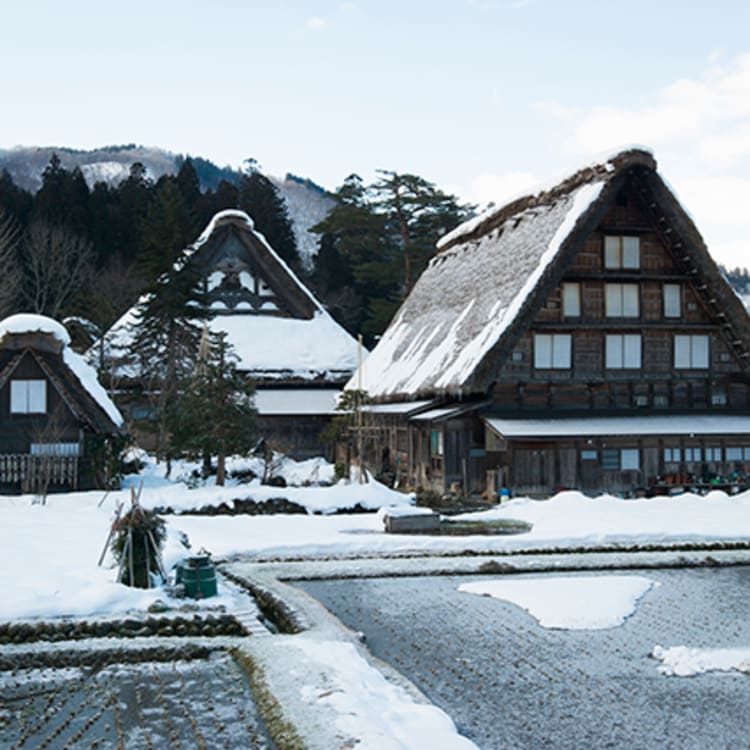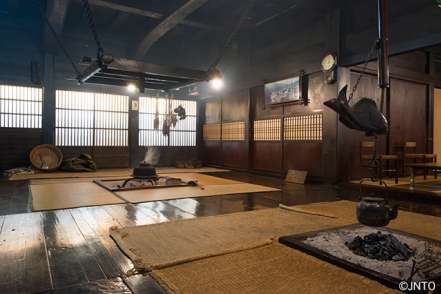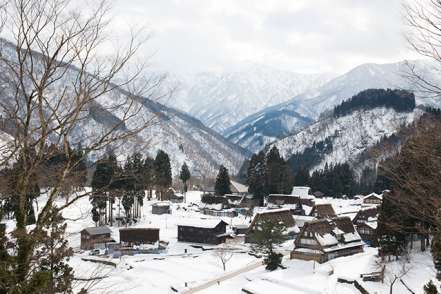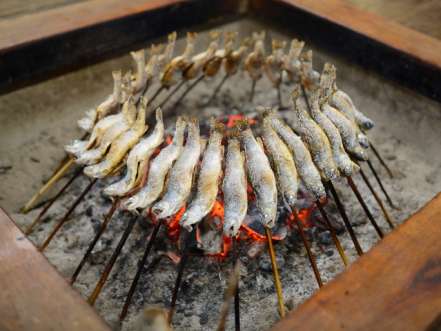
GUIDE Visiting the Gassho house of Shirakawa-go and Gokayama in Winter by JNTO on 11 September 2018
With its thousands of years of history, Japan offers countless hidden gems for the intrepid traveller, from temples and castles to its cuisine. Perhaps one of the most overlooked are its traditional gassho-zukuri (or gassho) houses. These centuries-old abodes – translated to ‘hands in prayer’ – with triangular thatched roofs can be found in several small villages deep in the mountains of Gifu, as well as neighbouring Toyama.
Gifu’s famous cedar trees are used to make the gassho homes in the ancient villages of Shirakawa-go and neighbouring Gokayama in Toyama Prefecture – these two form the UNESCO-listed “Historic Villages of Shirakawa-go and Gokayama”.
These villages are over 250 years old, and are still maintained to this day with their quaint thatched roofs, traditional sliding doors, and a unique attic space specially designed for silkworm cultivation. Locals – most of them original descendents of the townsfolk – survived by banding together, helping each other maintain their iconic thatched roofs or shovel snow off them.
Historically, it was the long, cold winters – which can dump one to two metres of snow – that shaped the landscape. The unique steep roofs of the gassho houses were designed to prevent heavy snowfall from accumulating on top.
Visiting Shirakawa-go
Shirakawa-go’s biggest village, Ogimachi boasts over a hundred thatched-roof homes hemmed in by the surrounding mountains, creating a magical setting in winter when it’s under a blanket of snow.
A great place to see the area’s living traditions is the Wada House (entrance 300 yen) in Ogimachi, which over the centuries has served as everything from a guard house for Edo-era tax collectors, to a gunpowder and silkworm factory.
One of the best ways to take in the whole of Shirakawa-go is from the nearby Shiroyama observation deck high above the valley.
Ogimachi also organises special illumination events on selected Sunday and Monday evenings in January and February when many of the village's gassho-zukuri farmhouses are lit up from 5.30pm to 7.30pm. Due to the overwhelming number of visitors, reservations are mandatory.

Visiting Gokayama
Neighbouring Gokayama is often far quieter than Shirakawa-go, generally seeing less than half of its visitors. Gokayama is well known for its washi paper, which you can try making on your own at several shops in the area.
There are two popular villages here: Suganuma with nine gassho-zukuri houses and Ainokura, the most remote and largest of the villages in Gokayama with 20 gassho-zukuri houses. While both still have original inhabitants and minshuku (family-run guesthouse), Gokayama Gassho no Sato (next to Suganuma) consists of traditional houses relocated here to save them from destruction.

Local Homestays
Guests can stay at any of a dozen or more minshuku homestays in gassho-zukuri houses in Ogimachi, Ainokura, and Suganuma, with rates from around 8,000-9,000 yen per person including dinner and breakfast.
It’s a great way to experience traditional life in these villages – sleep in a futon on tatami mats, and warm yourself up in winter with portable gas heaters. Some minshuku have their own ofuro (bathhouse), and toilet facilities are universally upgraded.
Numerous locally-run websites offer accommodation bookings at Shirakawago and Ainokura.
Famous Local Food - Shirakawa-go’s River Fish

Despite being located far inland, Shirakawago does boast its own local fish caught fresh from its pristine rivers.
These include ayu, or sweetfish, which as the name implies, does taste sweet. Served on a stick and left to grill over a fire, it has a crunchy texture and juicy, sweet flesh. Another common local fish is iwana, or white-spotted char. Like ayu, it’s usually eaten grilled, but it can be combined with one of the most quintessential elements of Japanese cuisine: sake. Iwana-kotsu-sake, literally “Iwana-bone sake”, is basically a whole-grilled Iwana steeped in hot sake, giving the drink its unique umami flavour.
One of the best ways to experience the area’s traditional cuisine is in a local minshuku homestay, like Gensaku Minshuku in Shirakawago. The home is over 300 years old, and combines a quaint setting (it has 4 tatami-style guest rooms) with authentic local cuisine which includes kaiseki-style dinners with ingredients like Hida beef, homemade tofu, and local river fish, all personally prepared by the family matriarch, Etsuko.
How to get to Shirakawa-go and Goyakama
From Tokyo, the fast connection is via the Hokuriku Shinkansen to Toyama (about 2.5 hours), and then transfer to a bus to Shirakawa-go (1.5 hours). You can also take the Hokuriku Shinkansen from Tokyo to Shin-Takaoka Station (3 hours) and transfer to the Kaetsuno Bus for Shirakawa-go (2 hours) which passes Ainokura and Suganuma along the way.
Date: Shirakawa-go and Gokayama are open all year round.
Time: 9am - 5pm (day visitors)
Entrance fee: Fees to each attraction within the villages are charged separately (mostly 300 yen)
























































